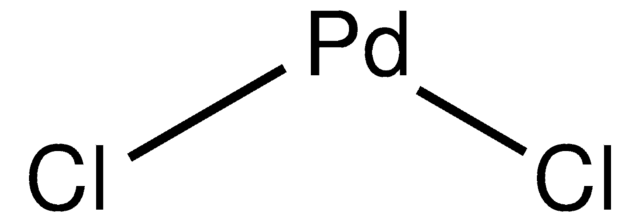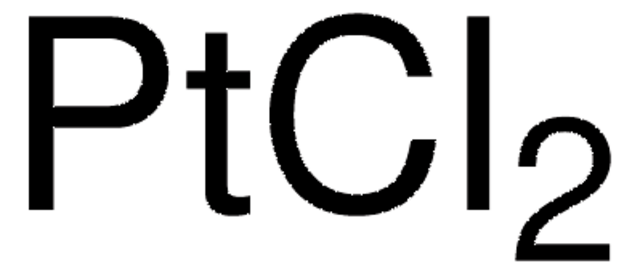205885
Palladium(II) chloride
ReagentPlus®, 99%
Synonym(s):
Dichloropalladium, Palladium dichloride, Palladous chloride
About This Item
Recommended Products
Quality Level
product line
ReagentPlus®
Assay
99%
form
powder
reaction suitability
core: palladium
reaction type: Buchwald-Hartwig Cross Coupling Reaction
reaction type: Heck Reaction
reaction type: Hiyama Coupling
reaction type: Negishi Coupling
reaction type: Sonogashira Coupling
reaction type: Stille Coupling
reaction type: Suzuki-Miyaura Coupling
reagent type: catalyst
mp
678-680 °C (lit.)
density
4 g/mL at 25 °C (lit.)
SMILES string
Cl[Pd]Cl
InChI
1S/2ClH.Pd/h2*1H;/q;;+2/p-2
InChI key
PIBWKRNGBLPSSY-UHFFFAOYSA-L
Looking for similar products? Visit Product Comparison Guide
General description
Application
Used in the synthesis of semiconducting metal-containing polymers in which the polypyrrole backbone has a conformational energy minimum and is nearly planar.
- PdCl2-CuCl2 catalytic system is used in the selective acetylation of 1o and 2o alkyl or aryl alcohols with vinyl acetate to prepare corresponding acetylated derivatives.
- PdCl2–EDTA is used in the Suzuki cross-coupling reaction between aryl and heteroaryl halides with aryl(heteroaryl)boronic acids in water.
- PdCl2-Cu(OAc)2 is used to synthesize polysubstituted pyrroles from phenethylamines via multiple deprotonations and deamination reactions.
- PdCl2-PEG(300) is used in the Suzuki-Miyaura coupling reaction.
- PdCl2-NaBH4 is used in the hydrogenation of carbon-carbon triple bonds to synthesize corresponding cis-alkenes in a polyethylene glycol-CH2Cl2 reaction medium.
- PdCl2-(n-Bu)3N-NH4OOCH catalytic system is used in the synthesis of benzofurans via intramolecular Heck reaction.
Legal Information
related product
Signal Word
Danger
Hazard Statements
Precautionary Statements
Hazard Classifications
Acute Tox. 4 Oral - Aquatic Acute 1 - Aquatic Chronic 1 - Eye Dam. 1 - Met. Corr. 1 - Skin Sens. 1
Storage Class Code
8B - Non-combustible corrosive hazardous materials
WGK
WGK 3
Flash Point(F)
Not applicable
Flash Point(C)
Not applicable
Personal Protective Equipment
Choose from one of the most recent versions:
Already Own This Product?
Find documentation for the products that you have recently purchased in the Document Library.
Customers Also Viewed
Our team of scientists has experience in all areas of research including Life Science, Material Science, Chemical Synthesis, Chromatography, Analytical and many others.
Contact Technical Service












